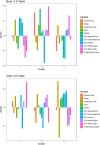Diet, Activity and Sleep Clusters Associated With Obesity Markers of Children in the US-Affiliated Pacific
- PMID: 39989394
- PMCID: PMC12147416
- DOI: 10.1111/apa.70012
Diet, Activity and Sleep Clusters Associated With Obesity Markers of Children in the US-Affiliated Pacific
Abstract
Aim: Among children in the US-Affiliated Pacific, we aimed to identify lifestyle clusters and associations with obesity.
Methods: Movement behaviours, diet and anthropometrics were from the Children's Healthy Living Program (n = 1780; 2012-2015). Partitioning-around-medoids identified clusters; regression examined differences in anthropometrics.
Results: Among 2-5-year-olds, boys' clusters were: (1) high %energy from (E%) fat and sedentary behaviour; (2) high screen time and energy intake and (3) long sleep. Body mass index z-score (zBMI) was lower in Cluster 3 versus 1 (-0.28 [-0.50; -0.07], p = 0.01). Girls' clusters were: (1) high energy intake; (2) low E% fat and (3) high physical activity and sleep. zBMI was lower in Cluster 3 versus 1 (-0.34 [-0.55; -0.13], p = 0.002). Among 6-8-year-olds, boys' clusters were: (1) high screen time; (2) high energy intake; (3) high E% protein; (4) long sleep and (5) high sedentary time and low E% saturated fat. Compared with Cluster 1, zBMI was lower in Clusters 3 (-0.43 [-0.84; -0.02], p = 0.04), 4 (-0.64 [-1.08; -0.20], p = 0.004) and 5 (-0.93 [-1.35; -0.51], p < 0.001). Girls' clusters were: (1) high E% fat and protein; (2) high screen time and energy intake; (3) short sleep and high physical activity (4) long sleep and (5) low sedentary time. Compared with Cluster 1, zBMI was lower in Clusters 2 (-0.57 [-0.98; -0.17], p = 0.006), 3 (-0.48 [-0.81; -0.14], p = 0.005) and 5 (-0.50 [-0.83; -0.18], p = 0.003).
Conclusion: Various lifestyle patterns support healthy body weight.
Trial registration: ClinicalTrials.gov identifier: NCT01881373.
Keywords: energy balance; macronutrient composition; movement behaviour; physical activity; screen time; sleep.
© 2025 The Author(s). Acta Paediatrica published by John Wiley & Sons Ltd on behalf of Foundation Acta Paediatrica.
Conflict of interest statement
The authors declare no conflicts of interest.
Figures



References
-
- Pate R., O'Neill J., Liese A., et al., “Factors Associated With Development of Excessive Fatness in Children and Adolescents: A Review of Prospective Studies,” Obesity Reviews 14, no. 8 (2013): 645–658. - PubMed
Publication types
MeSH terms
Associated data
Grants and funding
- DE230101174/Australian Research Council Discovery Early Career Award (DECRA)
- 1P20GM139753-01A1/NIH NIGMS
- GNT1176858/National Health and Medical Research Council
- P20 GM139753/GM/NIGMS NIH HHS/United States
- GNT1171981/National Health and Medical Research Council
- 2022-09708/USDA National Institute of Food and Agriculture
- Centre of Research Excellence Driving Global Investment in Adolescent Health
- 2021-68012-35899/USDA National Institute of Food and Agriculture
- 2018-69001-27551/USDA National Institute of Food and Agriculture
- 2011-68001-30335/USDA National Institute of Food and Agriculture

